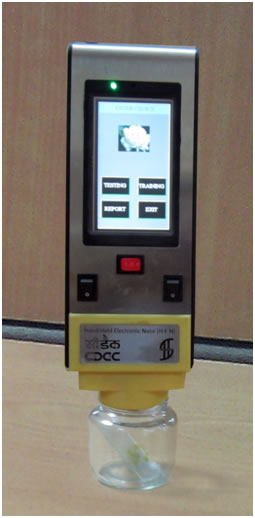Samples, made from jasmine flowers, of volume 15gm were tested under handheld e-Nose system, which produce a fragrance index of tested samples. Five Gas sensors have been identified and selected for the Electronic portable instrument after selectivity and sensitivity analysis of these sensors when exposed to aroma determining chemical compounds of Jasmine. In view of the processing power, memory and power constraints of the handheld instrument, we have chosen the best six (6) out of a few gas sensors in this phase. The selected sensors are grouped into two (i) sensors for fresh flower fragrance detection – TGS 823, TGS 826, TGS 832, TGS 2620 and TGS 2602; (ii) sensors for jasmine flower concrete fragrance detection - TGS 823, TGS 835, TGS 832, TGS 2620 and TGS 2602. Each sensor is tuned for odor of a family of volatile compounds. Odor stimulus imprints a characteristic electronic pattern as fingerprint (or smell print) on sensor array. This smell print is statistically classified and resolved with suitable pattern recognition engine as a measurement of odor of the sample. Overall aroma of Jasmine is a complex mixture of Volatile Flavoury Compounds (VFC).
After finalizing the Sensor Array, we exposed different species of Jasmine flowers to this array and found that this array was able to classify different species of Jasmine flower. The Principal Component Analysis (PCA) was done based on the response matrix consists of five individual sensor responses during its sampling time of the sniffing operation. Individual sensor response is considered to be the difference or the distance calculated from its base value to its ultimate stable value. The PCA plot in the Figure shows the classification ability of the sensor array. |

